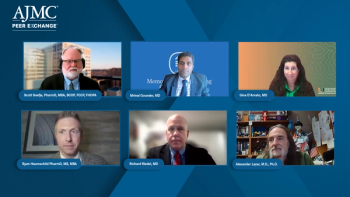
Current Guidelines and Unmet Needs Impacting Patients with Acne
Introduction of expert panelists and treatment guidelines for patients with acne.
Episodes in this series

Casey Butrus, PharmD: Hello, and welcome to this AJMC® Peer Exchange titled “Examining Novel Treatment Options for Patients With Acne Vulgaris.” My name is Casey Butrus. I’m a senior pharmacist with clinical pharmacy strategies at Highmark Inc in Pittsburgh, Pennsylvania. Joining me in this discussion are Dr Hilary Baldwin, the medical director of the Acne Treatment and Research Center and a clinical associate professor of dermatology at Robert Wood Johnson University Hospital in New Brunswick, New Jersey. Alongside me, I also have Arash Mostaghimi, an associate professor of dermatology at Brigham and Women’s Hospital in Boston, Massachusetts. Joining us virtually is Dr Steven Feldman, a professor of dermatology at Wake Forest University School of Medicine in Winston-Salem, North Carolina. We’re going to talk about several topics pertaining to acne vulgaris, including the unmet needs, expanding treatment landscape, and managed care considerations. With that, let’s get started.
Hilary, I want to start by discussing the treatment guidelines and what’s been previously discussed with expert opinion. A consensus group met last year to discuss the unmet needs of treatment in patients with acne. What were the findings of the Acne management consensus group, and what unmet needs are still left after that meeting?
Hilary Baldwin, MD: The impetus for the meeting was frustration. The frustration was because it takes so darn long to get acne guidelines out. The consequences of taking a long time for acne guidelines is that clinicians who need to use the guidelines—usually not the seasoned dermatologists, but doctors who are a little new to the field. For them, the guidelines are incomplete. It’s only a partial story. The other problem is that frequently if medications aren’t listed in the guidelines, then they’re not covered by managed care. Our last guidelines were in 2016, which means they were written in 2015 and based on literature in 2014 and before. Medicine advances faster than that. Relying on the guidelines to tell us what drugs we can and can’t choose was frustrating. The unmet need is to figure out how to solve that.
One way could be to have interim guidelines that are published every year ideally but maybe every other year, including only drugs that have gone through vigorous and rigorous trials, phase 3 trials, and things that have been FDA approved. Not case reports here and there, but drugs that have come out since the last guidelines. Maybe even rewrite the algorithm to include them where they need to be. The second unmet need would be for managed care companies to accept that data and hopefully include that drug in their armamentarium. Have a nice conversation about those new drugs so that individuals who need the guidelines to keep current can keep current.
Casey Butrus, PharmD: You mentioned that 2016 was the last time [the guidelines were updated]. There have been a lot of FDA approvals recently within the acne space. Arash, can you discuss the most recent American Academy of Dermatology guidelines? What are some strengths you think the guidelines emphasize, and what are some limitations that we want to see addressed in future guidelines?
Arash Mostaghimi, MD, MPH, FAAD: We’re in the midst of getting a new set of guidelines. The 2023 guidelines—maybe 2024; we’ll see when it comes out—are being developed. But Hilary caught the essence of both the strengths and weaknesses of the guidelines in her comments. The strength of the guidelines is that they’re incredibly rigorous in their creation and origin. It’s not just a group of individuals getting together and asking, “What do you do?” and deciding together. They take a very specific look at all the evidence, all the data, all the publications, and all the safety, and explore it to make sure they’re incorporating all the science into the guidelines.
The downside of that is if you’re going to be that rigorous and systematic in your approach, you’re going to be slow. You can’t be fast and do that at the same time. The way I think about it is that the guidelines are running on academic time. I say this because I’m an academic. They’re beautifully done and nicely crafted, but the world moves faster. New medicines are coming, decisions are being made, and science is moving faster than our ability to incorporate them. Even the guidelines that will be coming out aren’t going to have data from some things published in the last year or 2 since that new cycle got started. Even on the first day they’re published, they’ll be a little behind the times.
But because they’re done so rigorously, the nice part is that they not only provide a clinical road map for clinicians, patients, and anybody who’s interested in seeing the standard-of-care approach, but also make sure that when done properly, patients have access to the right medications. Where do these new medications fit in the order and course of care? When should we be willing to pay more for something that might be newer or more expensive? What are things that we should prioritize over other things? What are things that worked a long time ago, but now that the risks and benefits are better understood, they may not be things we should be using much anymore.
Casey Butrus, PharmD: From the managed care perspective, we’re waiting for some novel agents to be added to the guidelines so we know where they fit as a therapy compared with the generics that have been on the market for a long time.
Transcript edited for clarity.
Newsletter
Stay ahead of policy, cost, and value—subscribe to AJMC for expert insights at the intersection of clinical care and health economics.









































